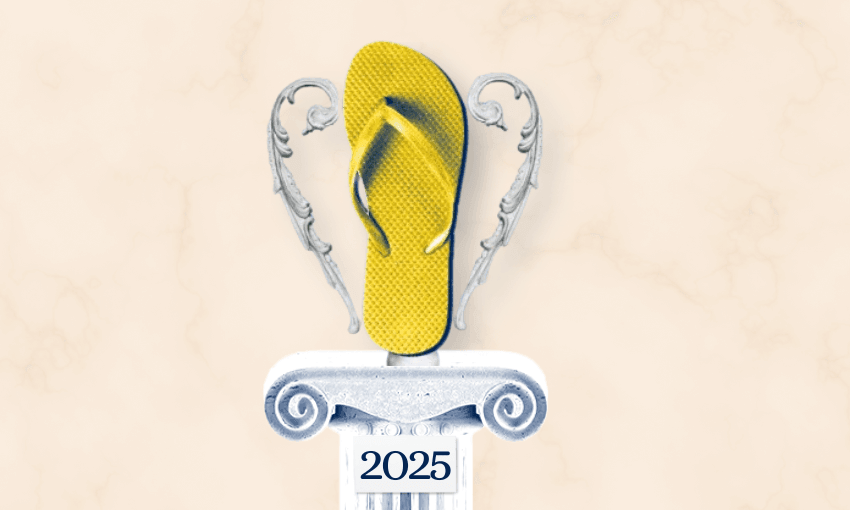More than 165 years after its founding, the Kingiitanga’s influence remains undimmed – as this weekend’s Hui aa Motu so powerfully demonstrated.
Bus after bus rumbled into Ngaaruawaahia, bringing people by the thousands. They came by car and by motorbike, tino rangatiratanga flags hoisted high as they thundered down the Waikato Expressway. Some even came on horseback, clip clopping their way through the town to Turangawaewae marae.
An estimated 10,000 people crowded into and around Tuurangawaewae for the Hui aa Motu called by Kiingi Tuheitia. In the sweltering heat, representatives from iwi and hapu across the land discussed and debated kotahitanga and mana motuhake, developing a united front in the face of government proposals around Te Tiriti o Waitangi and te reo Maaori.
The hui was a clear display of kotahitanga, but also a clear example of the mana and influence the Kiingitanga still holds more than 160 years after it was first founded, proving once again that it’s one of the country’s most enduring and influential institutions.
Yet for many Paakehaa New Zealanders – and even many in the Crown – the significance of the Kiingitanga is often little known or overlooked. Other times it’s belittled, which is a bizarre way to treat one of the few institutions that can rally a gathering of 10,000 with only a few weeks’ preparation.
What is the Kiingitanga?
Often dubbed the “Māori King” or the “Māori monarch”, Kiingi Tuheitia Potatau Te Wherowhero Potatau is the head of the Kiingitanga, a role he’s held since the death of his mother Te Arikinui Te Atairangikaahu in 2006.
The origins of the Kiingitanga lie in the assertion of mana motuhake. In the 1850s, when it started to become clear that the Crown wasn’t upholding its side of Te Tiriti, rangatira started to discuss ways of unifying their iwi nations as a means of going toe-to-toe with the British Crown. What developed was the idea of some kind of Māori kingship.
Various ariki were suggested, but at a hui convened by Iwikau Te Heuheu at Pūkawa, on the southern shores of Lake Taupō, in 1856, those rangatira chose Potatau Te Wherowhero of Ngāti Mahuta as the King of this new movement.
The Crown never warmed to the idea, let alone the reality, of a Māori king, and the Kiingitanga was instantly considered treasonous by the settler government. It set about trying to undermine and then destroy it, especially as many – though not all – hapuu were flocking to the Kiingitanga. In July 1863, all Māori living between Auckland and Waikato were told to either take an oath of allegiance to Queen Victoria or to flee south of the Mangatawhiri River, otherwise they would be evicted at gunpoint. Within 10 months, hundreds were dead and the second monarch, Potatau’s son Taawhiao, had been forced across the Puuniu River to the isolated hill country of Ngaati Maniapoto, the region now known as the King Country. The Crown then helped itself to thousands of hectares in Waikato.
In the years since, and through many monarchs, that preservation of mana motuhake has been central to the Kiingitanga, making it one of the few 19th century movements to endure despite land loss, war, and government efforts to stymie it. Tawhiao and Kiingi Te Rata made visits to London to petition the Crown, but they were undermined by New Zealand officials in both Wellington and London.
Do all iwi support it?
The Kiingitanga is not recognised by all iwi and hapuu, including large iwi Ngāpuhi and Ngāti Porou. There have been pointed disagreements, including last year’s flare up with Ngāti Whatua Ōrākei at the powhiri to open Te Matatini festival.
All that just adds to the significance of Saturday’s Hui aa Motu. That Ngāti Whatua Ōrākei, as well as Ngāpuhi, Ngāti Porou and Ngāi Tahu, all sent significant delegations to Tuurangawaewae shows the depth of feeling among te ao Māori about the government’s proposals. It also shows the significance of Tuheitia’s proclamation, and his ability to bring iwi together whether he’s seen as someone’s king or not.
Is it a political institution?
When NZ First’s Shane Jones last week said the hui would be “a monumental moan fest,” he criticised Tuheitia’s proclamation as “very political”. But the very fabric of the Kiingitanga is political, formed as a part of an effort to preserve Māori land, lives and ways of being.
Many of the words and actions from Tuurangawaewae have been political, from every Māori monarch. Tuheitia’s mother, Te Atairangikaahu, was leader Kiingitanga when the last such hui was held to protest the fiscal envelope in 1995. Throughout the 19th and 20th centuries the Kiingitanga has been central to Māori political movements, such as when the 1975 land march passed through Ngaaruawaahia, or when Te Atairangikaahu endorsed the hikoi to Waitangi in 1984.
Kiingi Tuheitia rarely speaks publicly, apart from the annual Koroneihana celebrations where he gives an address which can often contain political observations, sometimes even endorsements. Last year he said it was time for Māori to lead the change needed for Aotearoa’s future prosperity.
What is the Kiingitanga’s standing today?
The weekend’s hui shows the Kiingitanga still holds significant sway. Few institutions in this country are able to rally 10,000 people to discuss issues in the way Kiingi Tuheitia did with his proclamation. But outside of the Hui aa Motu, the Kiingitanga remains a significant player in te ao Māori, with many supporters.
The Poukai tours have been an institution since the time of Taawhiao, and the annual Koroneihana continues to be a signature event on the Māori calendar. The community projects started by Te Puea Herangi continue, as does the perseverance and advocacy for mana motuhake.
But it still often comes up against dismissive Crown attitudes, and is often overlooked as unimportant by the mainstream. Kiingitanga events rarely get the mainstream coverage seen last year, although maybe that’s blessing when you compare the wall-to-wall coverage of Charles’s enlarged prostate.
There was also the very public admonishment of the High Commissioner to the UK, Phil Goff, last year, when at a ceremony in London he declared that no one in the room had been to a coronation when Tuheitia was sitting right next to him.
“I think that time and time again our culture has been dismissed, really, as tokenism,” Rahui Papa, the kaikoorero mo te Kiingi, told RNZ after that faux pas in London. While we can’t be certain, the likelihood that Goff, a former cabinet minister and mayor of Auckland, was acting as a Ngāpuhi operative are slim.
Despite the obstacles, the Kiingitanga has endured for 165 years so far. And if Saturday’s display is anything to go by, it’s likely to continue as an influential force in the continuing pursuit of mana motuhake and tino rangatiratanga, whether Wellington decides to listen or not.
*Double vowels rather than macrons are used for kupu relating to Tainui.



